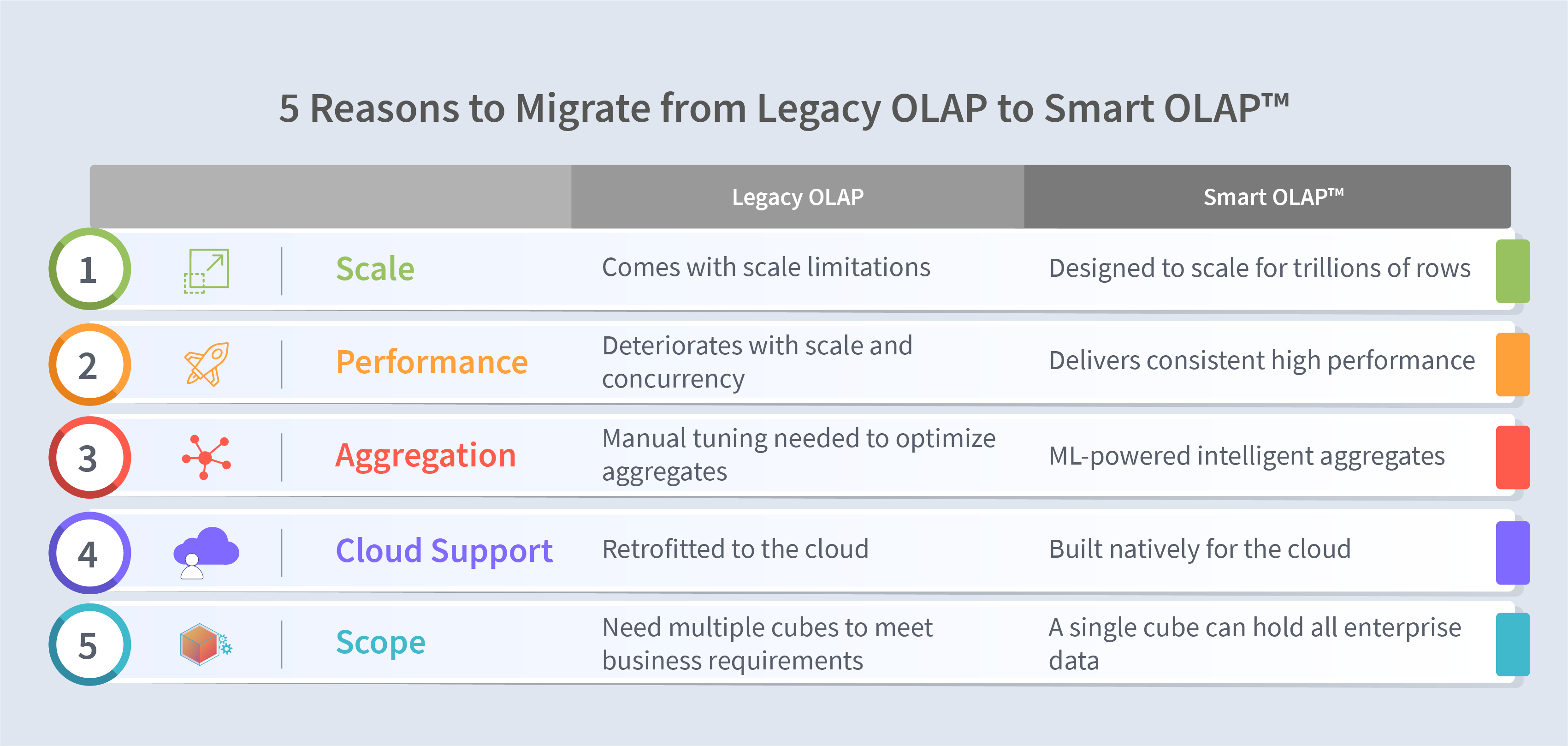Dealing with exploding data volumes and the growing complexity of modern-day analytics is one of the biggest challenges faced by Legacy OLAP solutions. In this blog, you will learn how Smart OLAP™ overcomes those challenges and why you should consider migrating from Legacy OLAP to Smart OLAP™ now.
Let’s Go Back to Where it All Began!
In the mid to late ’90s, businesses struggled to retrieve data from their databases. The response times of queries were slow, and they weren’t flexible enough to navigate the data. It was something that even the best processors of that time were unable to handle. This made business users realize that they needed a solution that would make data appear instantaneously, which ushered in the rise of OLAP.
OLAP was designed to minimize the amount of processing required while querying the data. Data was pre-aggregated, and all the possible combinations of dimensions, measures, and hierarchies were processed and stored before the analysis began to get instant responses to queries. So, when business users fired queries, the answers appeared instantaneously. OLAP revolutionized the world of analytics!
However, the arrival of massively scalable technologies like Hadoop, Spark, Cloud led to phasing out of Legacy OLAP tools. Data rose to significant levels, and legacy tools began to face severe limitations. They failed to perform as they could not deal with the massive increase in data volume, explosion of cardinality and dimensions, and the large variety of data sources. There were limits to the amount of data a single cube could process and hold, leading to scalability issues. Apart from this, the time taken to process these cubes increased significantly.
Fast Forward to the Era of Cloud and Data Explosion!
The biggest concern of this era is how to handle data explosion. Declining storage costs and easy availability of data led enterprises to accumulate more data each day. Additionally, to fully exploit data, enterprises now store it in the cloud. But what’s the point if you can’t analyze massive amounts of data with large numbers of dimensions and measures.
In fact, the need for OLAP is more significant today than it was ever before. There is no other technology out there that can match the speed and interactivity that OLAP provides. However, with the pace with which data is growing, it is simply impossible for Legacy OLAP technologies to scale up and deliver performance. To analyze billions and trillions of rows of data, you need cloud-native OLAP technology that is scalable and can transcend the limitations of speed and complexity.
Introducing Smart OLAP™ – A Solution Designed for the Cloud
Smart OLAP™ is an innovative concept that eliminates the analytics limitations of Legacy OLAP solutions. It builds optimized OLAP models directly on your cloud infrastructure, leveraging its scale and flexibility. Our patented technology is designed to handle the combinatorial explosion that happens while pre-aggregating trillions of rows of data, making it far superior to any other OLAP solution in the market. Let us delve deeper and see why you should be migrating from legacy OLAP to Smart OLAP.
#1 Don’t Limit Yourself by the Scale of Data.
Smart OLAP™ can handle trillions of rows, whereas Legacy OLAP comes with scale limitations.
Legacy OLAP technologies fail to keep up with the massive amounts of data landing into the cloud. The aggregations are stored in-memory. As a result, enterprises are forced to work within the memory limitations of the underlying infrastructure., They compromise on the level of aggregation and scope of analytics. Scaling becomes an expensive option.
Smart OLAP™ overcomes these challenges and builds scalable cubes using its advanced algorithms that enable aggregations on trillions of rows of data. With more and more data landing in your BI environment, Smart OLAP™ scales out transparently. Users can incorporate as many dimensions and measures as they want in the cubes depending on their business requirements. Additionally, linear scalability enables thousands of concurrent users to query the cubes without any significant impact on performance.
#2 No More Waiting. Get Response on Massive Data within Seconds.
Smart OLAP™ delivers consistent high performance whereas Legacy OLAP’s performance deteriorates with an increase in scale and concurrency.
Most in-memory OLAP solutions can handle frequent use cases, but they slow down for cold queries. As a result, there is a considerable degradation in query performance as scale and concurrency increase.
On the other hand, Smart OLAP™ technology materializes the cubes for speed. It provides instant responses even for heavy queries fired across hundreds of dimensions and measures. Users can drill down, slice and dice, query, filter, and explore remarkably massive datasets and get instant answers to their queries. Intelligent query engines and the robust querying mechanism ensure that results return in sub-seconds for all queries, whether standard, ad-hoc, cold, or hot.
#3 Bring in Intelligence and Get Faster with ML-powered Smart Recommendation Engine.
Smart OLAP™ uses ML and AI to build aggregates whereas Legacy OLAP needs manual optimization.
With Legacy OLAP, business users manually select the hierarchies and levels to build an aggregation. Thus, they need to perform manual tuning to build optimized cubes. This is not only time-consuming, but it also requires good knowledge of the data and query patterns.
On the other hand, Smart OLAP™ technology uses ML-powered Smart Recommendation Engine™ to create smart aggregates. It performs advanced data profiling and uses an intelligent query analyzer to study query patterns and provide recommendations that help build optimized cube designs without requiring technical expertise. This enables you to get started quickly and meet performance SLAs without the manual effort.
#4 Stay on top of your Digital Transformation Initiatives with a Solution built for the cloud.
Smart OLAP™ is a cloud-native solution, whereas Legacy OLAP has to be retrofitted on the Cloud.
Legacy OLAP has an old scale-up architecture, which means that you need to install it on a more extensive and expensive server to grow its capacity. Therefore, it cannot leverage the native elasticity of the cloud to scale up and down and optimize resources.
Smart OLAP™ is a cloud-native implementation of OLAP built on a scale-out architecture. It can scale infinitely, along with your cloud data platform. It supports parallelism, both for building cubes and querying, helping you deal with the scale and complexity of the modern data ecosystem while keeping a tab on the costs.
#5 Get a Consistent View of Business with a High-performing Smart Semantic Layer™.
Smart OLAP™ helps you build a Single Cube of Truth across the enterprise, whereas in Legacy OLAP you need to build multiple cubes to meet business requirements.
With the increase in data volumes, enterprises using Legacy OLAP create multiple cubes because there is a limitation on the data size that a single cube can hold. They often have to split their data and create separate cubes for different departments, uses cases, geographies, etc. Consequently, instead of accessing one single cube, analysts have to process data from multiple cubes. As these cubes do not talk to each other, there is a disconnect, leading to siloed reporting.
Smart OLAP™ can consolidate as much data as needed in a single cube, eliminating the need to create multiple smaller cubes. As there is no limitation on the data you can store in one cube, enterprises can create a single cube for all data. This way, you can achieve a single source of truth through a Smart Semantic Layer™.

OLAP gets a New Life with Smart OLAP™
Kyvos reinvented OLAP to deal with the scale and complexity of the modern data ecosystem. Smart OLAP™ is unique as it addresses real-world needs by bringing Legacy OLAP technologies to the analytic ecosystem of modern data platforms. If you want to scale analytics on the cloud, it is time to migrate OLAP from Legacy OLAP to Smart OLAP™.

